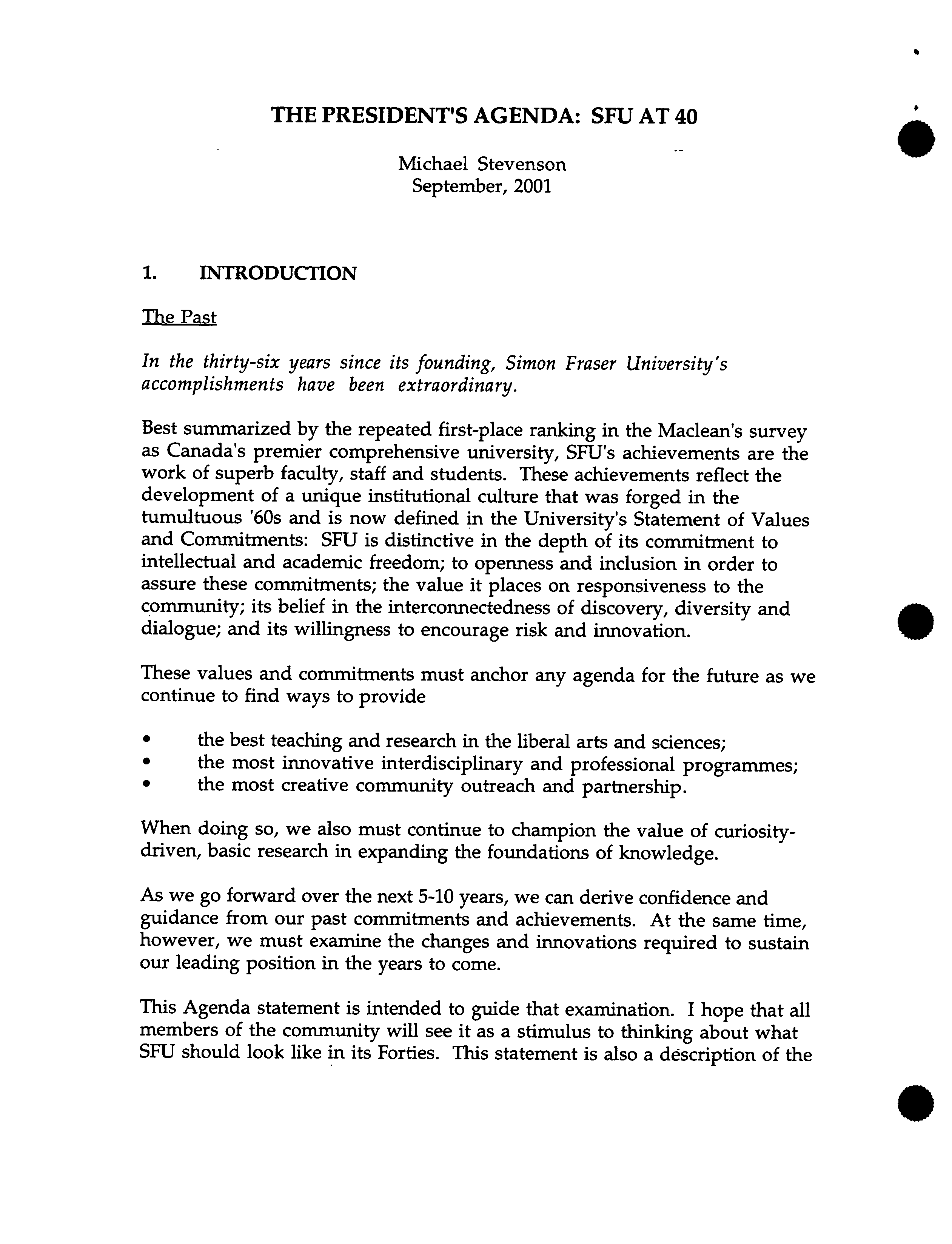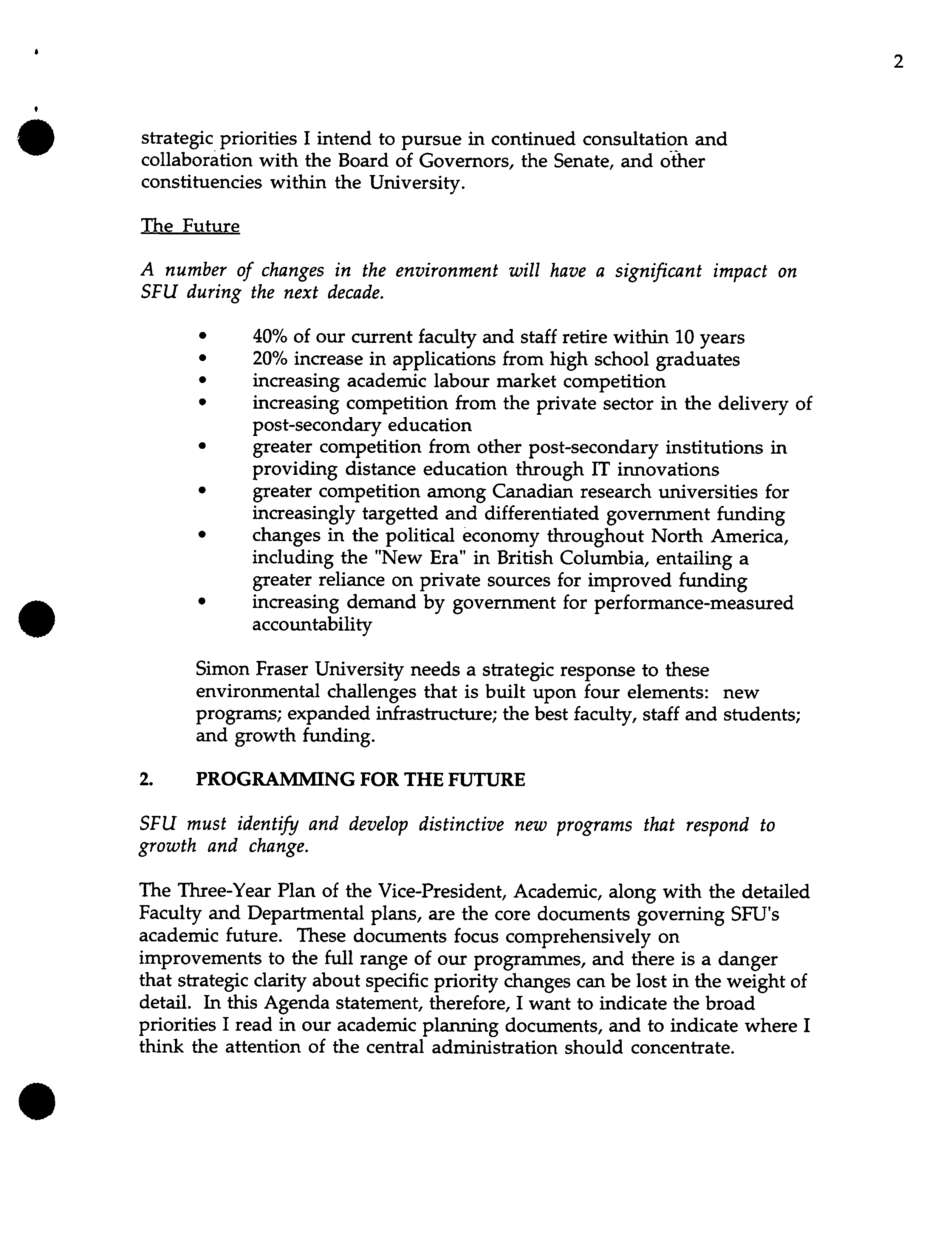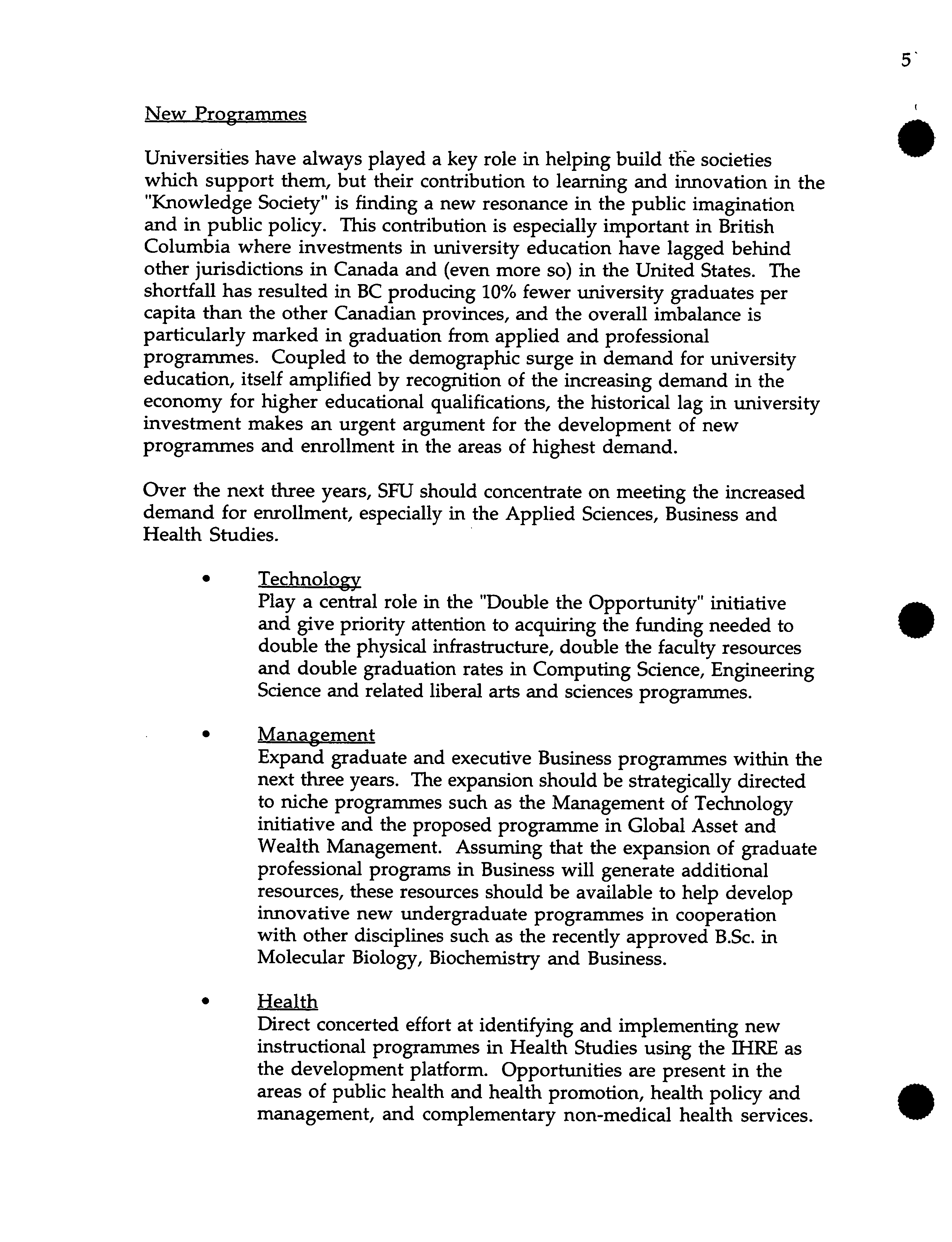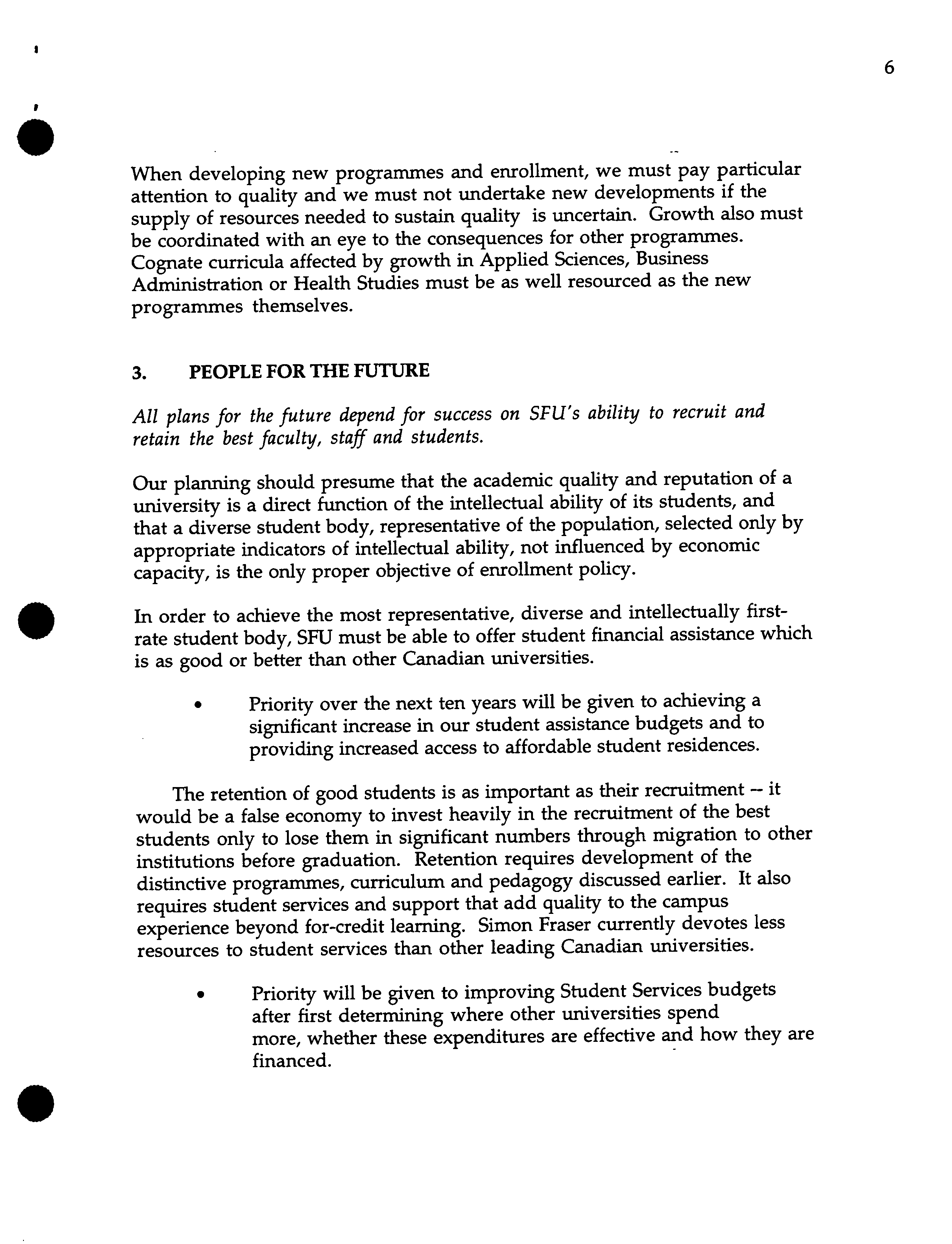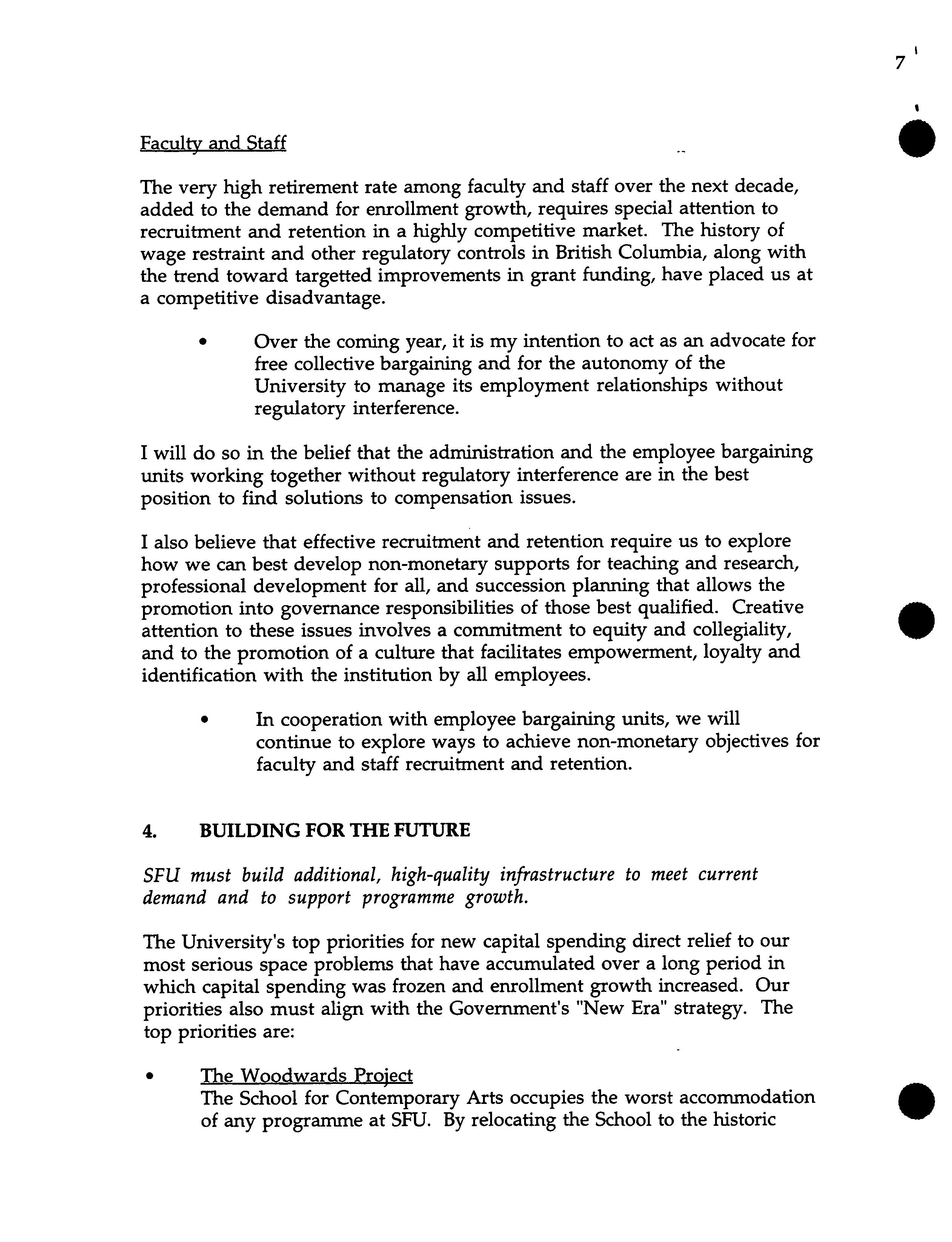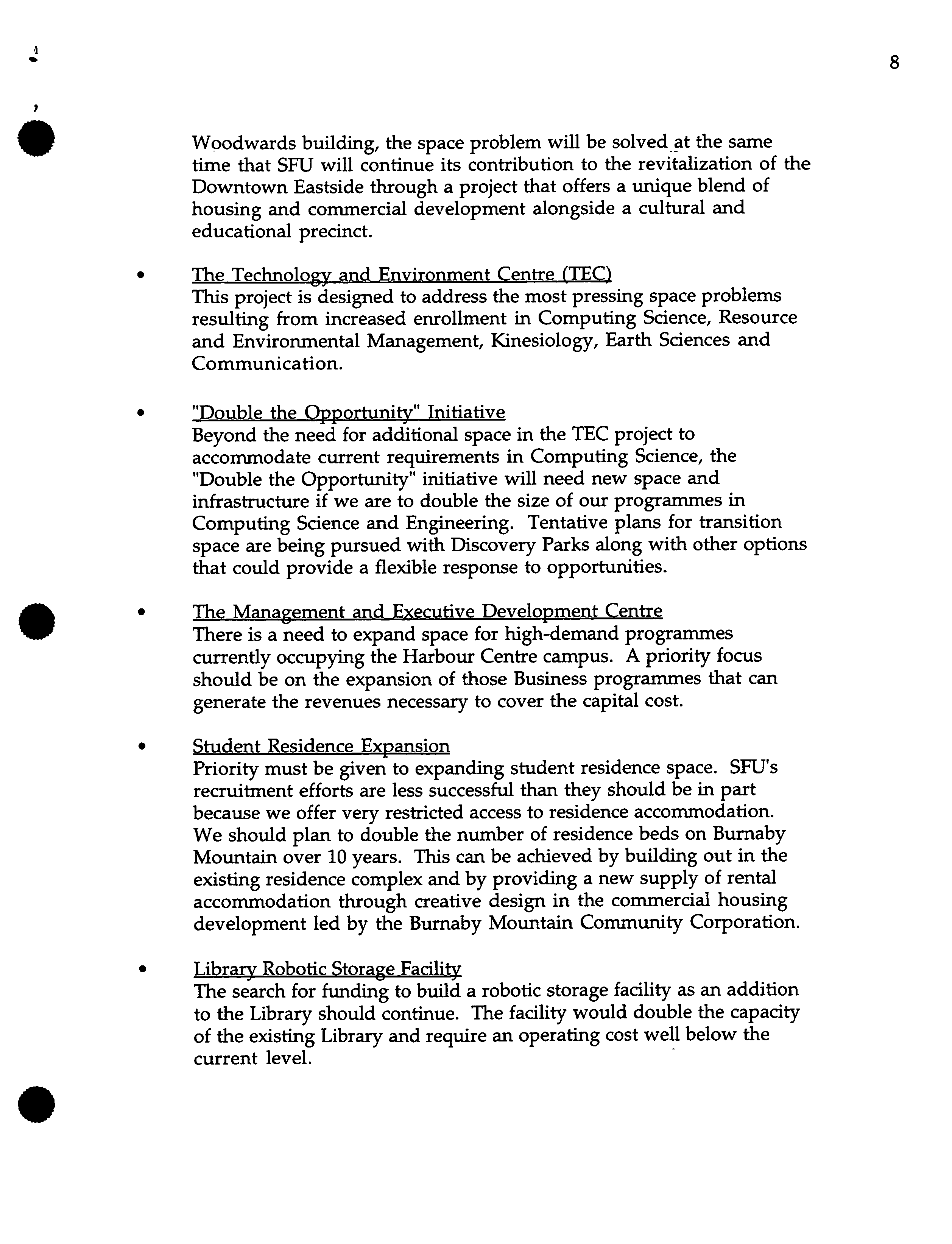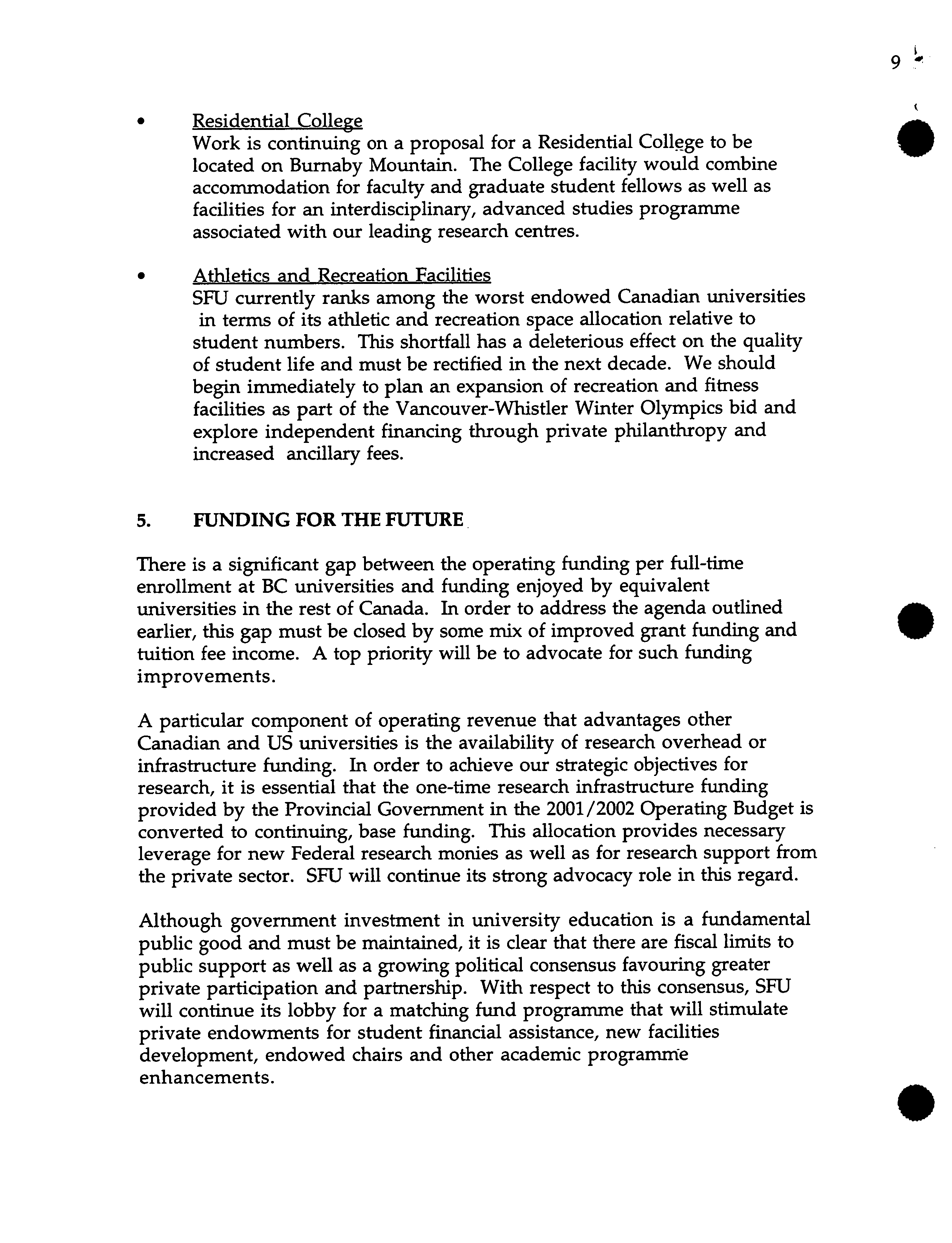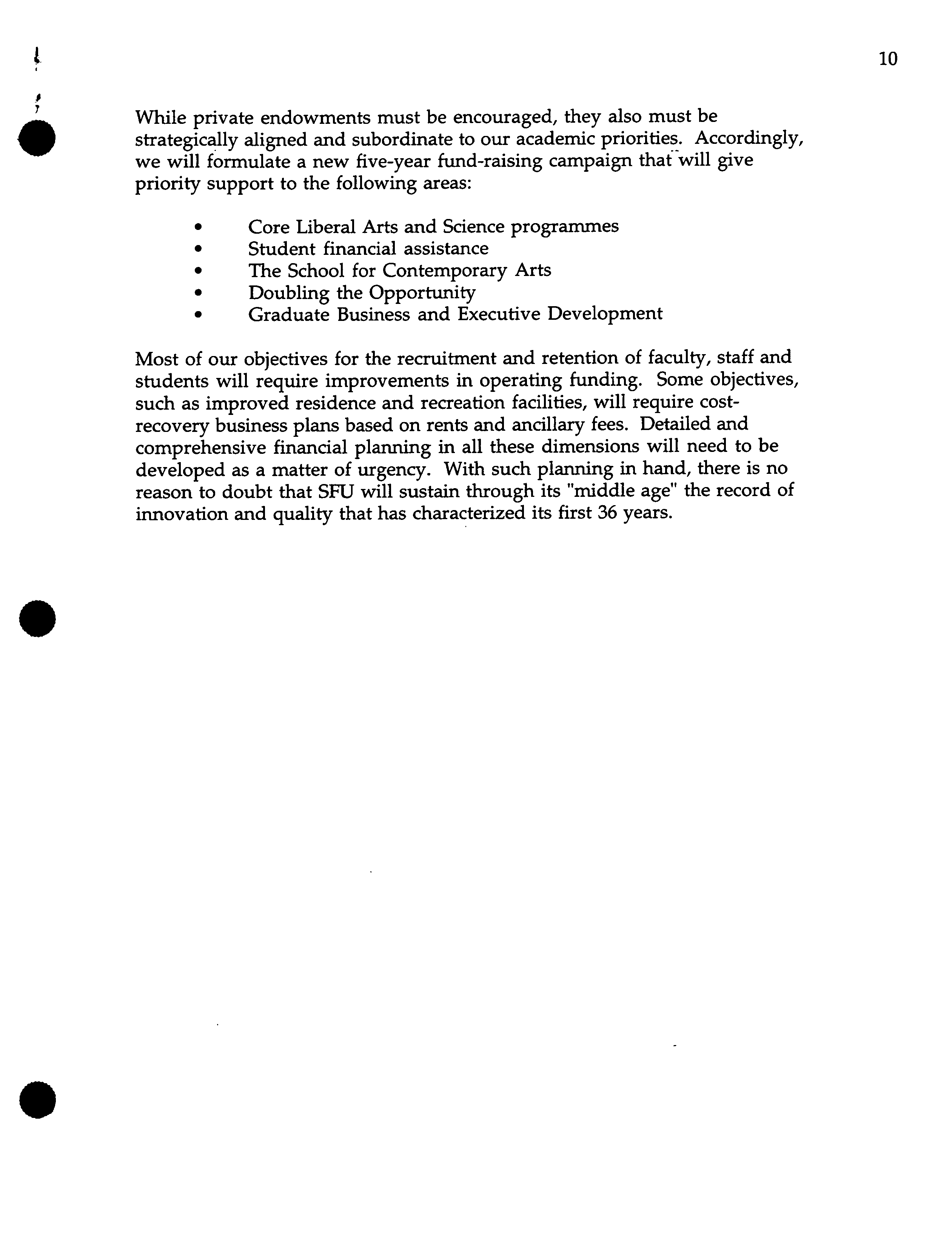S.O1-72
a
SIMON FRASER UNIVERSITY
OFFICE OF THE PRESIDENT
MEMORANDUM
To:
Senate
From:
Michael Stevenson, President and
Subject
President's Agenda
Date:
October 18, 2000
Attached are my objectives and priorities for the next year which were discussed with the
Board of Governors on September 27, 2001. I am forwarding this document to Senate for
comment and discussion.
Attachment
.
0
THE PRESIDENT'S AGENDA: SFU AT 40
Michael Stevenson
September, 2001
1. INTRODUCTION
The Past
In the thirty-six years since its founding, Simon Fraser University's
accomplishments have been extraordinary.
Best summarized by the repeated first-place ranking in the Maclean's survey
as Canada's premier comprehensive university, SFU's achievements are the
work of superb faculty, staff and students. These achievements reflect the
development of a unique institutional culture that was forged in the
tumultuous '60s and is now defined in the University's Statement of Values
and Commitments: SFU is distinctive in the depth of its commitment to
intellectual and academic freedom; to openness and inclusion in order to
assure these commitments; the value it places on responsiveness to the
community; its belief in the interconnectedness of discovery, diversity and
dialogue; and its willingness to encourage risk and innovation.
These values and commitments must anchor any agenda for the future as we
continue to find ways to provide
•
the best teaching and research in the liberal arts and sciences;
•
the most innovative interdisciplinary and professional programmes;
•
the most creative community outreach and partnership.
When doing so, we also must continue to champion the value of curiosity-
driven, basic research in expanding the foundations of knowledge.
As we go forward over the next 5-10 years, we can derive confidence and
guidance from our past commitments and achievements. At the same time,
however, we must examine the changes and innovations required to sustain
our leading position in the years to come.
This Agenda statement is intended to guide that examination. I hope that all
members of the community will see it as a stimulus to thinking about what
SFU should look like in its Forties. This statement is also a description of the
0
strategic priorities I intend to pursue in continued consultation and
collaboration with the Board of Governors, the Senate, and other
constituencies within the University.
The Future
A number of changes in the environment will have a significant impact on
SF11 during the next decade.
•
40% of our current faculty and staff retire within 10 years
•
20% increase in applications from high school graduates
•
increasing academic labour market competition
•
increasing competition from the private sector in the delivery of
post-secondary education
•
greater competition from other post-secondary institutions in
providing distance education through IT innovations
•
greater competition among Canadian research universities for
increasingly targetted and differentiated government funding
•
changes in the political economy throughout North America,
including the "New Era" in British Columbia, entailing a
greater reliance on private sources for improved funding
•
increasing demand by government for performance-measured
accountability
Simon Fraser University needs a strategic response to these
environmental challenges that is built upon four elements: new
programs; expanded infrastructure; the best faculty, staff and students;
and growth funding.
2.
PROGRAMMING FOR THE FUTURE
SF11 must identify and develop distinctive new programs that respond to
growth and change.
The Three-Year Plan of the Vice-President, Academic, along with the detailed
Faculty and Departmental plans, are the core documents governing SFU's
academic future. These documents focus comprehensively on
improvements to the full range of our programmes, and there is a danger
that strategic clarity about specific priority changes can be lost in the weight of
detail. In this Agenda statement, therefore, I want to indicate the broad
priorities I read in our academic planning documents, and to indicate where I
think the attention of the central administration should concentrate.
2
0
Curricula Review
Given the shifting environmental pressures that are bringing increased
choice and competition to post-secondary education, SF0 must ensure that its
academic programmes display the highest academic quality while proving
attractive to students. Potential faculty recruits must see SF0 programmes as
offering a uniquely challenging interplay between research and teaching in
dialogue with superb colleagues and students. Potential private donors must
see SF0 programmes as the most innovative and responsive to social,
cultural and economic needs.
The
A d hoc Committee to Review and Develop the Undergraduate Curricula
(UCC), will be instrumental in addressing these challenges. Because the UCC
is fully engaged in its work at present, I do not wish to speculate about its
recommendations other than to express my confidence that there will be a
clear assessment of key issues, including:
•
programme distinctiveness
•
innovative and effective pedagogy
•
student-centered learning
•
experiential learning
•
research-intensive learning
•
information access, applied technology skills, and
perspectives on technology
Internationalization
No matter what new directions are taken in curricula and pedagogy over the
next five years, I am convinced that a university education in an era of ever
greater global interconnection must provide a sophisticated understanding of
international and intercultural diversity. All students should be expected to
acquire some direct experience of a different culture and society, and they
should be supported in finding ways to do so that will be reflected in academic
credit.
The multicultural reality of our urban environment and of our own
institutional demography alone cannot be assumed to provide this
experience, although properly used it should facilitate the
internationalization of our programmes. Likewise, our location on the
Pacific Rim gives us a unique opportunity for international partnerships and
regional focus, especially in Asia and the American hemisphere.
In all fields, we should be building on our successful record for international
partnership and for securing development assistance funding. We should be
3
more proactive in facilitating applications to programmes that support
trilateral partnerships and mobility linked to NAFTA and the EU, and we
should be aggressive in pursuing other multilateral partnerships and
mobility opportunities in strategic areas of research and instruction.
Research Coordination
Differentiation and competition among universities is perhaps most marked
with respect to research. The research funding environment in Canada has
increasingly favoured applied science, health science and technology research
programmes. Targetted funding to such programmes has been very
significant in the last decade, while there has been far less improvement in
funding for basic research in the liberal arts and sciences. The funding
environment is biased in favour of universities with medical schools and
large health sciences and engineering programmes, and against universities
like SFU with a large concentration of activity (and excellence) in the liberal
arts and sciences. This bias also gives a competitive advantage to the larger
institutions (even in the liberal arts and sciences) by allowing a greater
measure of financial flexibility and cross-subsidization to support basic
research.
•
If we are to maintain our position as the most research intensive
comprehensive university in Canada, we will need to focus greater strategic
effort on securing research support. Although we must find ways to do even
better in the core research competitions run by SSHRC and NSERC, the real
test will be our ability to capitalize on research opportunities where targetted
funds are available through initiatives such as SSHRC's New Economy
programme, the Centres of Excellence initiative, the Canada Foundation for
Innovation and the Major Collaborative Research Initiatives programme.
In order to meet this test, we must move quickly to develop strategic plans for
each discipline and to establish clusters of excellence in key areas. In this
regard, I am committed to making our Institute for Health Research and
Education (IHRE) a flagship initiative that will promote new research
opportunities across our science, applied sciences, humanities and social
science programmes.
The Vice-President, Research, working with the Deans, should establish
reasonable targets for improving our success in basic research funding
competitions and in targetted research programmes. They should examine
the adequacy of our present research support and find ways to coordinate
applications on the large scale proposals now favoured by many Federal
programmes. Finally, the development of an overall research strategy
should take place in consultation with the new Research Advisory Board.
4
New Programmes
Universities have always played a key role in helping build tFie societies
which support them, but their contribution to learning and innovation in the
"Knowledge Society" is finding a new resonance in the public imagination
and in public policy. This contribution is especially important in British
Columbia where investments in university education have lagged behind
other jurisdictions in Canada and (even more so) in the United States. The
shortfall has resulted in BC producing 10% fewer university graduates per
capita than the other Canadian provinces, and the overall imbalance is
particularly marked in graduation from applied and professional
programmes. Coupled to the demographic surge in demand for university
education, itself amplified by recognition of the increasing demand in the
economy for higher educational qualifications, the historical lag in university
investment makes an urgent argument for the development of new
programmes and enrollment in the areas of highest demand.
Over the next three years, SF0 should concentrate on meeting the increased
demand for enrollment, especially in the Applied Sciences, Business and
Health Studies.
Technology
Play a central role in the "Double the Opportunity" initiative
and give priority attention to acquiring the funding needed to
double the physical infrastructure, double the faculty resources
and double graduation rates in Computing Science, Engineering
Science and related liberal arts and sciences programmes.
Management
Expand graduate and executive Business programmes within the
next three years. The expansion should be strategically directed
to niche programmes such as the Management of Technology
initiative and the proposed programme in Global Asset and
Wealth Management. Assuming that the expansion of graduate
professional programs in Business will generate additional
resources, these resources should be available to help develop
innovative new undergraduate programmes in cooperation
with other disciplines such as the recently approved B.Sc. in
Molecular Biology, Biochemistry and Business.
•
Health
Direct concerted effort at identifying and implementing new
instructional programmes in Health Studies using the IHRE as
the development platform. Opportunities are present in the
areas of public health and health promotion, health policy and
management, and complementary non-medical health services.
5
a
When developing new programmes and enrollment, we must pay particular
attention to quality and we must not undertake new developments if the
supply of resources needed to sustain quality is uncertain. Growth also must
be coordinated with an eye to the consequences for other programmes.
Cognate curricula affected by growth in Applied Sciences, Business
Administration or Health Studies must be as well resourced as the new
programmes themselves.
3.
PEOPLE FOR THE FUTURE
All
plans for the future depend for success on SF U's ability to recruit and
retain the best faculty, staff and students.
Our planning should presume that the academic quality and reputation of a
university is a direct function of the intellectual ability of its students, and
that a diverse student body, representative of the population, selected only by
appropriate indicators of intellectual ability, not influenced by economic
capacity, is the only proper objective of enrollment policy.
In order to achieve the most representative, diverse and intellectually first-
rate student body, SF0 must be able to offer student financial assistance which
is as good or better than other Canadian universities.
Priority over the next ten years will be given to achieving a
significant increase in our student assistance budgets and to
providing increased access to affordable student residences.
The retention of good students is as important as their recruitment - it
would be a false economy to invest heavily in the recruitment of the best
students only to lose them in significant numbers through migration to other
institutions before graduation. Retention requires development of the
distinctive programmes, curriculum and pedagogy discussed earlier. It also
requires student services and support that add quality to the campus
experience beyond for-credit learning. Simon Fraser currently devotes less
resources to student services than other leading Canadian universities.
Priority will be given to improving Student Services budgets
after first determining where other universities spend
more, whether these expenditures are effective and how they are
financed.
-
6
0
7
FTahe
culvety
ry
and
high
Sta
r
f
e
f
tirement rate among faculty and
staf f
over the next decade,
0
added to the demand for enrollment growth, requires special attention to
recruitment and retention in a highly competitive market. The history of
wage restraint and other regulatory controls in British Columbia, along with
the trend toward targetted improvements in grant funding, have placed us at
a competitive disadvantage.
Over the coming year, it is my intention to act as an advocate for
free collective bargaining and for the autonomy of the
University to manage its employment relationships without
regulatory interference.
I will do so in the belief that the administration and the employee bargaining
units working together without regulatory interference are in the best
position to find solutions to compensation issues.
I also believe that effective recruitment and retention require us to explore
how we can best develop non-monetary supports for teaching and research,
professional development for all, and succession planning that allows the
promotion into governance responsibilities of those best qualified. Creative
attention to these issues involves a commitment to equity and collegiality,
and to the promotion of a culture that facilitates empowerment, loyalty and
identification with the institution by all employees.
In cooperation with employee bargaining units, we will
continue to explore ways to achieve non-monetary objectives for
faculty and staff recruitment and retention.
4. BUILDING FOR THE FUTURE
SF11 must build additional, high-quality infrastructure to meet current
demand and to support programme growth.
The University's top priorities for new capital spending direct relief to our
most serious space problems that have accumulated over a long period in
which capital spending was frozen and enrollment growth increased. Our
priorities also must align with the Government's "New Era" strategy. The
top priorities are:
The Woodwards Project
The School for Contemporary Arts occupies the worst accommodation
of any programme at SFU. By relocating the School to the historic
8
Woodwards building, the space problem will be solved at the same
time that SFU will continue its contribution to the revitalization of the
Downtown Eastside through a project that offers a unique blend of
housing and commercial development alongside a cultural and
educational precinct.
The Technology and Environment Centre (TEC)
This project is designed to address the most pressing space problems
resulting from increased enrollment in Computing Science, Resource
and Environmental Management, Kinesiology, Earth Sciences and
Communication.
•
"Double the Opportunity" Initiative
Beyond the need for additional space in the TEC project to
accommodate current requirements in Computing Science, the
"Double the Opportunity" initiative will need new space and
infrastructure if we are to double the size of our programmes in
Computing Science and Engineering. Tentative plans for transition
space are being pursued with Discovery Parks along with other options
that could provide a flexible response to opportunities.
.
•
The Management and Executive Development Centre
There is a need to expand space for high-demand programmes
currently occupying the Harbour Centre campus. A priority focus
should be on the expansion of those Business programmes that can
generate the revenues necessary to cover the capital cost.
Student Residence Expansion
Priority must be given to expanding student residence space. SFU's
recruitment efforts are less successful than they should be in part
because we offer very restricted access to residence accommodation.
We should plan to double the number of residence beds on Burnaby
Mountain over 10 years. This can be achieved by building out in the
existing residence complex and by providing a new supply of rental
accommodation through creative design in the commercial housing
development led by the Burnaby Mountain Community Corporation.
Library Robotic Storage Facility
The search for funding to build a robotic storage facility as an addition
to the Library should continue. The facility would double the capacity
of the existing Library and require an operating cost well below the
current level.
-
9
Residential College
Work is continuing on a proposal for a Residential College to be
located on Burnaby Mountain. The College facility would combine
accommodation for faculty and graduate student fellows as well as
facilities for an interdisciplinary, advanced studies programme
associated with our leading research centres.
Athletics and Recreation Facilities
SFU currently ranks among the worst endowed Canadian universities
in terms of its athletic and recreation space allocation relative to
student numbers. This shortfall has a deleterious effect on the quality
of student life and must be rectified in the next decade. We should
begin immediately to plan an expansion of recreation and fitness
facilities as part of the Vancouver-Whistler Winter Olympics bid and
explore independent financing through private philanthropy and
increased ancillary fees.
5.
FUNDING FOR THE FUTURE
There is a significant gap between the operating funding per full-time
enrollment at BC universities and funding enjoyed by equivalent
universities in the rest of Canada. In order to address the agenda outlined
earlier, this gap must be closed by some mix of improved grant funding and
tuition fee income. A top priority will be to advocate for such funding
improvements.
A particular component of operating revenue that advantages other
Canadian and US universities is the availability of research overhead or
infrastructure funding. In order to achieve our strategic objectives for
research, it is essential that the one-time research infrastructure funding
provided by the Provincial Government in the 2001/2002 Operating Budget is
converted to continuing, base funding. This allocation provides necessary
leverage for new Federal research monies as well as for research support from
the private sector. SF0 will continue its strong advocacy role in this regard.
Although government investment in university education is a fundamental
public good and must be maintained, it is clear that there are fiscal limits to
public support as well as a growing political consensus favouring greater
private participation and partnership. With respect to this consensus, SF0
will continue its lobby for a matching fund programme that will stimulate
private endowments for student financial assistance, new facilities
development, endowed chairs and other academic programme
enhancements.
9
I
0
L.
10
While private endowments must be encouraged, they also must be
strategically aligned and subordinate to our academic priorities. Accordingly,
we will formulate a new five-year fund-raising campaign that will give
priority support to the following areas:
•
Core Liberal Arts and Science programmes
•
Student financial assistance
•
The School for Contemporary Arts
•
Doubling the Opportunity
•
Graduate Business and Executive Development
Most of our objectives for the recruitment and retention of faculty, staff and
students will require improvements in operating funding. Some objectives,
such as improved residence and recreation facilities, will require cost-
recovery business plans based on rents and ancillary fees. Detailed and
comprehensive financial planning in all these dimensions will need to be
developed as a matter of urgency. With such planning in hand, there is no
reason to doubt that SFU will sustain through its "middle age" the record of
innovation and quality that has characterized its first 36 years.
C


